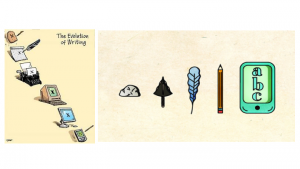
While Bolter (2001) provides a historically accurate picture of writing within the limits of the date of publication, we have the benefit of 17 more years of experience with technology and its advances from which to extrapolate the further progress of the written word.
Prior to the first carvings into stone, there was the Spoken word. Stories were passed down from generation to generation. Hunting grounds and their location, the usefulness, friendliness and availability of trading partners was passed along via the spoken word. As history continues to chug along, the elite were able to make use of the printed word through education and technology. Going forward even further to Gutenberg and Bolton points out how the printed word becomes more accessible to the masses. From the printing press to the typewriter the typewriter to the word processor we come to modern day. I am “writing” this post with the assistance of my handheld computer (aka iPhone). I am not typing a word. I don’t need to know how these words are spelled. I don’t even really need to know where punctuation has to be inserted perhaps until I get to the editing process [because I want full marks for this academic endeavour]. So, where are we headed? The written word is more than the technology one uses to write it. The written word is also the exchange of ideas. Have we come full circle? Can I now say that I can use the spoken word to get my academic ideas from my brain to yours via text? I could record this is a video file and send it to you, send you an audio file? But given the nature of this assignment, I’ve chosen to have my computer transcribe it for you into written text and display for you on a computer screen – our communal medium of choice in 2018.
What is lost in the written process when I am vocalizing my thoughts rather than struggling to type them, transferring from brain to the fingers, fingers to the keyboard, keyboard to the screen? Is there a message that I can get across more effectively because I can skip the motor function translation from brain to finger and go directly from brain to screen? As I replied to a post from a self-proclaimed millennial, have we come to the point in history where the need to know how to use a print device such as typewriter or pencil has passed us by? What does this mean for us as educators? Particularly for me as a kindergarten educator, I spend probably more than 50% of my time working on fine motor skills so that the children in my class can be successful in getting their ideas down on paper. In a very short period of time, well this part of my job be gone the way of the dinosaur?
Have we come full circle? Will the future of the ‘peer-reviewed journal’ be a ‘peer-reviewed podcast’? Or, as was evidenced in our first weeks when I struggled to use a pure audio file and needed to add a written transcript, has the ability to add text and audio brought the written word to the masses and increased the reach of the world of academia?
I can see the headlines now. “Oral Communication – The New Normal!” Or the latest declaration from Apple, “We have brought back the spoken word!”
Everything old is new again!
References:
Bolter, J. (2001). Writing space : Computers, hypertext, and the remediation of print (2nd ed.). Mahwah, N.J. ; London: Lawrence Erlbaum.
Evolution of Writing Instrument[Painting]. (n.d.). Retrieved June 16, 2018, from http://www.funbuzztime.com/satirical-evolution-cartoons-sad-reality-or-fate/
The Evolution of Writing[Painting]. (n.d.). Retrieved June 16, 2018, from https://www.thclabs.org/deep-trip-series/the-unexplored-art-of-being-a-writer/evolution-of-writing-when-the-arts-student-speaks/



sally bourque
June 16, 2018 — 6:01 pm
Hi Carrie-Ann,
Your post made me think about the following passage from Bolter. “The oral poet is a writer, who writes exclusively in the minds of his or her audience.” (2001, p. 16) This was stated in the context of arguing that orality is no more natural than writing, and writing with pen and paper no more natural than writing on a computer screen.
I am surprised to learn that there is such a gap in fine motor skills among kindergarten students, though I suppose it makes some logical sense if they are growing up using a tablet more than pen and paper. Perhaps the students of this generation are going to be excellent orators compared to generations before. Also, I wonder if this will only affect one generation because of the come-back of the pen/pencil in the form of the e-stylus?
This reminds me of an English class more than 10 years ago. We had an assignment to record someone speaking for 10-15 minutes, manually transcribe it, and then compare it to a sample of the same person’s writing. I recorded one of my professor’s while she was lecturing, and though I didn’t notice while I was listening, as I transcribed I realized it was filled with repetitions, incomplete sentences, uhms and ahhs, and was quite terrible to read. However, listening was different. The same text, so horrible to read was easy to listen to.
Biakolo provides several examples of the biases that exist in examining/comparing written vs. oral discourse. In one example he says “Hildyard and Olson stated repeatedly that the children who read well, listen well also…[but] since what is being tested goes beyond mere language skills, how does this correlate with other intellectual abilities? Why do the authors feel constrained to offer only linguistic or language related explanations for the superiority in comprehension of good readers?” (Biakolo, 1999 p. 58) I think there have been biases in education around literacy for a long time. On social media, there are always several people ready to pounce on small grammatical errors, often using the “correction” as a passive aggressive opportunity to dismiss what has been said by implying that “This person is not even smart enough to use words correctly…therefore their statement must also be incorrect.” Logically, of course, not being proficient with the rules of sentence structure doesn’t mean you don’t know other things, but there is a stigma that it does that was born in a school system that privileges reading and writing as the top forms of communication.
To bring this back to your idea that “oral communication may be the new normal” – I think you’re right! I mean with YouTube, Periscope, transcription, and virtual assistants we have many possibilities for speaking and listening. It does seem like societies have just been re-mixing different methods of speaking and writing since the development of both- I wonder what a real leap or change in communication would look like?
Carri-Ann Scott
June 17, 2018 — 11:58 am
Thanks, Sally.
I share your wonder. What is the next leap in communication?
When, if ever, does the bias toward the literate or the definition of literate change? To be literate, do you need to know how to read AND write? Or will other forms of communication emerge to replace the written word?
I can see the day when a published manuscript is not available in paper format. Electronic communication and e-readers are quickly adapting so that finding information in my textbooks is already easier with the electronic copy. When you think that that manuscript may also be available in an audio book format, will there ever be a day when one replaces the other?
With my feet firmly in the last century, I cannot envision a day without text. But I am not willing to admit that it cannot happen.
NathanLott
June 17, 2018 — 10:13 am
Thank you for your post, it got me thinking along another tangent about my daughter in Kindergarten and her experiences with literacy there. She is now starting to read and is sounding out every word she sees. We have been working diligently on writing with her as well, as you say, trying to help her with her fine motor skills and correct spelling. Yet on the side, and it is taking up more and more of her time as she requests it, is her learning how to speak to the computer through coding. She is slowly learning to speak the computers language which is a form of literacy that I really think is becoming increasingly important as our world slowly automates. As a teacher I find that while students are adapt at ipad navigation and can get onto a you tube channel faster than a speeding bullet they completely lack the ability to converse with the computer, to create from it rather than consume what is feed to them. To speak in the computers language, to control it and use its vast power to create anything you can imagine is to me a skill that we pay lip service to but is far from entrenched in our educational system.
I totally agree with you that oral communication is our new normal and it certainly does make our lives easier and more comfortable and that is because of our relationship with technology. Yet as computers evolve and become increasingly complex there sits a language, text, ones and zeros, that as a general population we have little understanding of. I am not a programmer and really, my daughters interests may wax and wane as she moves through life. However a basic understanding of the language, the text that controls the machines we use everyday would go a long way for creating a computer literate population and a more productive society. Perhaps I am straying a bit from your original post but I think better understanding how to “speak” to these machines that control so much of our society should be a fundamental skill that we need to pass to our students. Soon with Artificial Intelligence I think the machines control will surpass our own if we do not learn to communicate with it in its language.
Carri-Ann Scott
June 17, 2018 — 11:52 am
Thanks, Nathan.
Yours is an interesting thought.
I have been a code writer. I remember the days of debugging BASIC code, hand-coding HTML, and then migrating to the WYSIWYG world of website development with Microsoft’s FrontPage.
Here’s a shout out to all the Star Trek fans. Perhaps the type of communication for creation you are talking about with computers will lead us to the creation of the Hollo-Deck. “Computer, I’d like a warm day, soft white clouds, a comfy chair and a cold, fermented, fruit-based beverage.” That would be great! But, even in Star Trek, there are engineers that are working with their hands on some sort of interface to develop new programs or tweak a system.
You are right. Our children will have to know how to speak to computers in many ways. Their ideas of literacy and text will be very different from our own. That said, how many ahead generations are we considering for this change? My grandchildren (in their 20s now) still navigate a world that is, for the most part, sharing the ideals and ideas of literacy with my generation. That is, the printed text in whatever form. How far ahead, if ever, do we see a world where text is archaic? What is lost in that scenario?
steve campbell
June 21, 2018 — 6:58 am
Thank you for such an interesting post. This reminds me of my times of helping university students with their written essays. I would always tell my students that if they wanted to correct their essays and find errors, they should read their essay ‘aloud’. They could always find and correct many mistakes in their writing by bringing their written work into the oral arena. These mistakes were usually simple grammar mistakes and missing logical connections. On the other hand, when I conduct peer-instructor reviews of my colleagues and evaluate their spoken presentations, I notice that during presentations they make many mistakes of repetition and non-sequitur remarks. It seems to me, like in your post, people generally have strengths and weaknesses in communication depending on the method they employ. Ong certainly felt that employing different communication styles had different results, “The very reflectiveness of writing – enforced by the slowness of the writing process as compared to the oral delivery (…) encourages growth of consciousness out of the unconscious.” (Ong, 2015, p. 147).
I am excited to see where our new technologies take us, but I am hesitant to celebrate the over-dominance of one style of communication over another. I can see the advantages and disadvantages of different methods of communication and would welcome a world of balance where the myriads of communication methods are relatively equally employed. I fear, however, that the needs of the world determine the overly-dominant communication method; be it orality, written, print, visual etc. If the new world we are entering requires a ‘digital orality’, so be it. As such, my greatest concern in education is that educational institutions prepare students for the world they will live in, not the world that has passed.
References
Hartley, J. (2015) After Ongism. in Ong, W. J. (2015). Orality and Literacy: The technologizing of the Word, (30th Anniversary Ed.). London;New York;: Routedge.
amy
June 23, 2018 — 4:48 pm
Hi Carri-Ann,
I thoroughly enjoyed reading your post. Ong (1982) paraphrases Plato’s Phaedrus by describing the philosopher’s aversion for written language, stating that “[t]hose who use writing will become forgetful, relying on an external resource for what they lack in internal resources” (p. 78). He also says that, “[w]riting [and relying on writing to assist memory] weakens the mind” (p.78). In contrast, Ong (1982) believes that language is extremely oral. You also mentioned in your post, “[p]rior to the first carvings into stone, there was the Spoken word. [Then, s]tories were passed down from generation to generation” (Scott, para. 2). One of the methods I use in my classroom to emphasize oral communication is the TPR Storytelling technique, invented by Blaine Ray, a Spanish teacher in California, in 1990 (Rowan, 2018). Storytelling is a fun and effective technique to teaching languages to students. The idea behind the TPR Storytelling technique is that when you tell stories to students you are immersing them in rich language in context, which in turn leads to higher levels of language retention in speech, literacy and writing. Language teachers use this approach to introduce new language skills such as vocabulary and grammar, as the stories make those concepts easier to understand and remember.
My stories are created through a collaborative process with my students. The stories are always memorable with strange characters and even stranger plots, which I find increases engagement. I discuss meanings of words and explain grammar concepts as I am telling the story, rather than having students write down and memorize groups of words and grammar rules. As the story develops, I check in with my students for comprehension and provide clarification when needed. Students’ understanding of the vocabulary and grammar are from within the story. As a result, when students go to produce the language they have already heard it, worked with the meaning, and have used it in context. It is through story telling that I find that my students are better able to understand, retain, and produce the language with more confidence. I have found that oral storytelling definitely makes a difference in my language class. Has anyone else come full circle in your instruction?
References
Ong, Walter. (1982). Orality and Literacy: The Technologizing of the Word. London: Methuen
Rowan, Karen. (2018. June 23). TPRSories.com: Teaching Proficiency Through Reading & Storytelling. Retrieved from http://tprstories.com/
Scott, Carri-Ann. (2018, June 23). From Oral Language Text and Back Again. The Cycle Continues! [Blog post]. Retrieved from https://blogs.ubc.ca/etec540summer2018/2018/06/16/from/
marcia kondo
June 29, 2018 — 2:13 pm
Hi Carri-Ann,
Your post reminds me of several things that I have been reading and writing about as I work on my video documentary project. My topic is The invention of the typewriter/the history of teaching printing/how word processing fits into this picture of young children learning to print and write. As you can see, I still haven’t quite defined the title yet!
Anyway, as an early childhood educator myself, I struggle with some of the same questions. Is all of the time we put into strengthening fine motor skills, proper posture, pencil grip, prewriting loops/curves/waves all for nothing? Will these skills simply vanish and have no use at all? I have to believe that no, this is definitely not the case. Developing and refining these fine motor skills will come in handy in many ways throughout life, even if not necessarily through using a pencil or pen. Painting, drawing, playing a musical instrument, woodworking, chemistry, jewelry making, pharmaceuticals, surgery, cake decorating, electrical work, building computers, playing video games even, all require outstanding fine motor skills that one might not have had their teacher not spend so much time developing them in Kindergarten!
I love your description of announcing iPad time to your students. I remember having the same reaction with a class of mine a few years ago. It is such a wonderful feeling to see such joy in children at what we may see as such a small thing but it is these moments that brighten up a day and what makes the students’ day memorable, too. In my opinion, we need a mix of the old and the new in the classroom to keep things fresh and moving forward. It is difficult for me to imagine a preschool or Kindergarten classroom without paper, picture books, pencils, ink pads, stamps, stickers, crayons and markers. Could a “Writers’ Workshop” Centre really just be a table with ipads on top? Maybe one day it will, who knows?!
I appreciate you ending your post with some humour, too! “Oral Communication-The New Normal!” Sadly, I have several friends whom I have only been in touch with through text and email since moving away from my hometown. I should change that…
Marcia